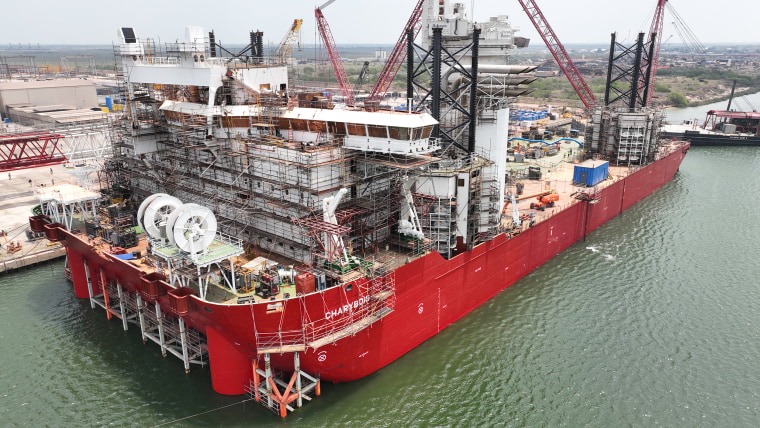
A key to Biden’s lagging wind energy goal will set sail after the election
BROWNSVILLE, Texas — The United States is producing less than 1% of the wind power it wants to generate by 2030. But an enormous boat promising to change that is about 89% built, and when it’s done next year, the real race to catch up begins.
The ship, named the Charybdis after a mythological Greek sea monster, won’t set sail until next year, potentially after one of the most pro-green energy administrations in history has left the White House. And as Eric Hines, the director of Tufts University’s offshore wind energy graduate program, puts it, “We’re going to need somewhere on the order of five of these installation vessels in just a few years.”
The Biden administration wants the U.S. to generate 30,000 megawatts from wind power within the next five and a half years. As of last year, that figure stood at just 42 megawatts, putting the nation far behind Europe — which added 18,300 megawatts of new wind energy capacity in 2023 alone, according to WindEurope.
The Charybdis under construction at a Brownsville, Texas, shipyard.Dominion
In recent years, constructing massive offshore windmills has come with headwinds from supply chain snags to higher interest rates. But the U.S. faces an added logistical puzzle from a 100-year-old maritime law that, along with those other factors, has contributed to project delays and even cancellations.
The outcome of November’s election isn’t likely to affect the Charybdis, whose operator plans to take advantage of green energy tax credits in the Inflation Reduction Act. But the prospect of a new administration much less keen on renewables could hamper additional projects.
Republican presidential candidate Donald Trump claimed at a New Jersey rally in May that offshore wind installations harm whales, saying, “We are going to make sure that ends on day one. I am going to write it out in an executive order.” (“There are no known links between large whale deaths and ongoing offshore wind activities,” the National Oceanic and Atmospheric Administration has said.)
The first major parts of the boat were laid down in 2020, kicking off a $625 million project between Dominion Energy and Seatrium AmFELS, which is building the massive vessel in its Brownsville, Texas, shipyard. At over 30,000 tons and with 58,000 square feet of deck space, the Charybdis will be able to transport 12 blades at a time, each measuring 357 feet and weighing 60 tons.
We’re going to need somewhere on the order of five of these installation vessels in just a few years.
Tufts University Prof. Eric Hines
Just as important as its technical specs, the boat will also be able to meet the requirements of the Jones Act, a 1920 merchant marine law that says cargo shipped from one point to another within the U.S. must be carried by an American vessel. And so far, there’s no American vessel capable of carrying wind turbine parts directly from shore to installation sites miles off the coast.
The Charybdis’ first project will be Dominion’s offshore wind farm under development 24 miles east of Virginia Beach. Once completed, its 176 turbines are expected to deliver 2,600 megawatts of energy, enough to power over 900,000 homes. But to install its first two pilot turbines, it had to stage the parts in Canada to comply with the Jones Act, adding long travel times and related costs.
“Obviously, you don’t want to install a large project like that,” said Mark Mitchell, the Dominion Energy senior vice president overseeing the Coastal Virginia Offshore Wind project — which, at $9.8 billion, is currently the largest and priciest in the country.
